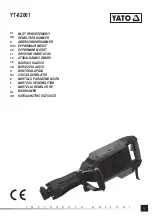
4.1.5.
Line pressure should be increased to compensate for unusually long air hoses (over 8 metres). The minimum hose diameter should be
1/4” I.D. and fittings must have the same inside dimensions.
4.1.6.
Keep the hose away from heat, oil and sharp edges. Check hose for wear, and make certain that all connections are secure.
4.2.
COUPLINGS
Vibration may cause failure if a quick change coupling is connected directly to the wrench. To overcome this, connect a leader hose to
the wrench. A quick change coupling may then be used to connect the leader hose to the air line recoil hose. See fig’s.1 & fig.2.
5. OPERATION
WARNING!
Ensure you read, understand and apply safety instructions before use.
5.1.
With seized or rusted nut use a penetrating oil and a spanner to “crack” the fixing.
5.2.
Fit the required socket to the wrench.
5.3.
Connect the wrench to the air hose as indicated in section 4.
5.4.
Place the socket over the subject nut and depress the trigger to operate the wrench.
5.5.
To change the wrench direction turn the switch on the head of the wrench, F = Clockwise, R = Anti-clockwise.
8
DO NOT
use worn or damaged sockets.
8
DO NOT
use any additional force upon the wrench in order to remove a nut; it is possible to damage the head by using excessive
hand force.
8
DO NOT
allow the wrench to free run for an extended period of time as this will reduce bearing life.
6. MAINTENANCE
WARNING!
Disconnect wrench from air supply before changing accessories, servicing or performing maintenance. Replace or
repair damaged parts. Use genuine parts only. Un-authorised parts may be dangerous and will invalidate the warranty.
6.1.
If the air system does not have an oiler, lubricate the air wrench daily with a few drops of Sealey air tool oil dripped into the air inlet to
prolong its life.
6.2.
Clean the wrench after use with a dry cloth.
6.3.
Loss of power or erratic action may be due to the following:
a) Excessive drain on the air line. Moisture or restriction in the air pipe. Incorrect size or type of hose connectors. To remedy check the
air supply and follow instructions in section 4.
b) Grit or gum deposits in the wrench may also reduce performance. If your model has an air strainer (located in the area of the air
inlet), remove the strainer and clean it. Flush the wrench out with gum solvent oil or an equal mixture of SAE No 10 oil and
paraffin. Allow to drain before use.
6.4.
For a full service contact your local Sealey service agent.
6.5.
When not in use, disconnect from the air supply, clean the wrench with a dry cloth and store in a safe, dry, childproof location.
WARNING! – Risk of Hand Arm Vibration Injury.
This tool may cause Hand Arm Vibration Syndrome if its use is not managed adequately.
This tool is subject to the vibration testing section of the Machinery Directive 2006/42/EC.
This tool is to be operated in accordance with these instructions.
This tool has been tested in accordance with:
EN ISO 28927-2:2009 & BS EN ISO 15744:2008.
Declaration and verification of Vibration Emission figures are in accordance with EN 12096:1997
Measured vibration emission value (a): 0.996 m/s²
Uncertainty value(k):
0.594 m/s²
Please note that the application of the tool to a sole specialist task may produce a different average vibration emission. We recommend that a
specific evaluation of the vibration emission is conducted prior to commencing with a specialist task.
A health and safety assessment by the user (or employer) will need to be carried out to determine the suitable duration of use for each tool.
NB:
Stated Vibration Emission values are type-test values and are intended to be typical.
Whilst in use, the actual value will vary considerably from and depend on many factors.
Such factors include; the operator, the task and the inserted tool or consumable.
NB:
ensure that the length of leader hoses is sufficient to allow unrestricted use, as this also helps to reduce vibration.
The state of maintenance of the tool itself is also an important factor, a poorly maintained tool will also increase the risk of Hand Arm Vibration
Syndrome.
Health surveillance.
We recommend a programme of health surveillance to detect early symptoms of vibration injury so that management procedures can be modified
accordingly.
Personal protective equipment.
We are not aware of any personal protective equipment (PPE) that provides protection against vibration injury that may result from the uncontrolled
use of this tool. We recommend a sufficient supply of clothing (including gloves) to enable the operator to remain warm and dry and maintain good
blood circulation in fingers etc. Please note that the most effective protection is prevention, please refer to the Correct Use and Maintenance section
in these instructions. Guidance relating to the management of hand arm vibration can be found on the HSC website www.hse.gov.uk - Hand-Arm
Vibration at Work.
Original Language Version
© Jack Sealey Limited
fig.1
fig.2





















